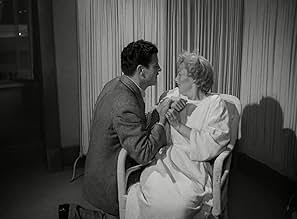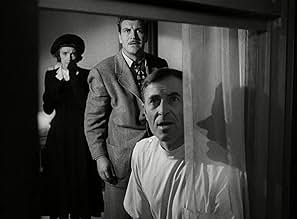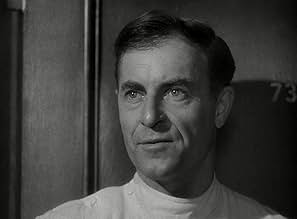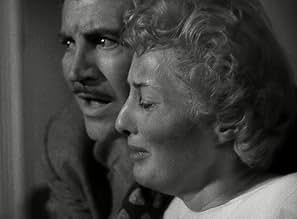VALUTAZIONE IMDb
6,6/10
1161
LA TUA VALUTAZIONE
Aggiungi una trama nella tua linguaA desperate husband tries to find help for his wife suffering from addictive gambling.A desperate husband tries to find help for his wife suffering from addictive gambling.A desperate husband tries to find help for his wife suffering from addictive gambling.
- Regia
- Sceneggiatura
- Star
- Premi
- 3 vittorie totali
Philip Van Zandt
- Chuck
- (as Phil Van Zandt)
Tony Curtis
- Bellboy
- (as Anthony Curtis)
Peter Leeds
- Jack Harrison - Hotel Clerk
- (as Peter Lewis)
Recensioni in evidenza
It is very evident that Barbara Stanwyck was able to adapt to any sort of role or character in each of her pictures. In this one, she plays a businessman's wife who becomes addicted to gambling after a trip to Las Vegas. This isn't a bad character study, and probably one of the earliest ones dealing with this sort of obsession. It is also interesting to see how the Vegas strip looked in over 50 years ago. A young, unknown Tony Curtis has a cameo as a bell boy.
This is one of the best films about the madness of gambling. As a former compulsive gambler, I can really relate to this film. The only other film about gambling addiction that could be better is The Great Sinner starring Gregory Peck. I don't like to tell the plot on my reviews, and I won't now either. Barbara Stanwyk does an incredible job as a woman that gets obsessed gambling. When she describes how it's a "good tired" after a night of gambling( after she wins) and how Stephen McNally describes the good tired even after you lose. Both logics are so true. Stanwyks performance is brilliant as a lunatic gambler. If you're a gambler or an ex over the top gambler, you'll enjoy this film.
Barbara Stanwyck is surely one of the greatest actresses ever in motion pictures but THE LADY GAMBLES is one of her lesser works despite a sincere, empathic performance by the star. This movie seems to want to be the gambling version of THE LOST WEEKEND but it's more like the lost 100 minutes , the time the viewer wastes watching this picture. Even the charismatic Stanwyck can't prevent this heavy-handed drama from being a chore to watch.
Stanwyck stars as the wife of newspaper journalist Robert Preston. They are in Las Vegas while he covers a story. Stanwyck decides to try to do an article herself on the gambling scene but her somewhat indiscreet camera work catches the eye of casino manager Stephen McNally who decides to let her play with valueless chips so she can be at the tables for her research. Trouble is Stanwyck finds she likes the tables a little too much and when McNally decides to put a plug in the playing for nothing, she dives into Preston's expense account and loses it all in a night. McNally, clearly attracted to Stanwyck from first sight, gives her $50 to play with out of pity after she has even hawked her expensive Swiss camera and being the good player she is Stanwyck actually wins her money back. But the lure of the tables is too strong and she keeps going back. And back. And losing. Ultimately destroying her marriage, she eventually joins forces with McNally in some of his questionably legal activities and later hits earthier lows in pursuit of lady luck where one seedy guy after another tells her to "kiss 'em for me baby" as she rolls the dice.
The movie is told in flashback as Stanwyck is hospitalized having been beat up by gamblers when she is caught dealing in a back alley crap game with loaded dice. Estranged husband Preston rushes to her side and tells the doctor the whole sad story.
The usually dependable Preston is one of the weakest links in the film; his character is alternately a milquetoast and a control freak but is at all times presented as Stanwyck's prince charming. Preston's performance is no help either, his rather theatrical delivery seems inappropriate for this attempt at "slice of life" drama; worse, in an amazingly unwise decision he speaks to the doctor in anguished troubled tones and then his narration over the past scenes is spoken with enthusiasm and dramatic flair! Stephen McNally fares much better as the intimidating Vegas big shot, his scenes with Stanwyck have considerable bite and are the film's highlight.
The worst thing about the film is the jaw-dropping pop psychology that attempts to explain away Stanwyck's gambling. It's because of her possessive older sister Edith Barrett!!! With her mother dying during childbirth, Stanwyck was "raised" by older (eight years, although Barrett was actually just six months older than Stanwyck) sister who has never let Barbara forget the sacrifices in her personal life she has made for her. Hero Preston seems frankly as controlling but since he is her husband, presumably that's OK with the screenwriters. The sister-is-the-root theory is interesting considering (A) Preston is hostile to the sister and her relationship with Barbara long before the gambling starts, (B) the gambling doesn't even start until Stanwyck is clearly into her thirties and (C) the sister is no where around to cause anxiety when most of the gambling binges occur!! But then what can you expect of reason from a film where a doctor attempts reverse psychology, encouraging a patient on a building ledge to jump!!
Barbara Stanwyck is always worth watching, her progression from dabbler to desperate is quite credible but even her solid work here can't save a movie that plays like a 1940's version of a 1970's half-baked "social issue" TV movie. Two stars going in opposite directions are also in the cast: newcomer Tony Curtis has an early bit part as a bellhop and 30's leading man Leif Erickson can be seen in a small role as one of McNally's questionable cohorts. Is this picture worth checking out? Well, it's your gamble.
Stanwyck stars as the wife of newspaper journalist Robert Preston. They are in Las Vegas while he covers a story. Stanwyck decides to try to do an article herself on the gambling scene but her somewhat indiscreet camera work catches the eye of casino manager Stephen McNally who decides to let her play with valueless chips so she can be at the tables for her research. Trouble is Stanwyck finds she likes the tables a little too much and when McNally decides to put a plug in the playing for nothing, she dives into Preston's expense account and loses it all in a night. McNally, clearly attracted to Stanwyck from first sight, gives her $50 to play with out of pity after she has even hawked her expensive Swiss camera and being the good player she is Stanwyck actually wins her money back. But the lure of the tables is too strong and she keeps going back. And back. And losing. Ultimately destroying her marriage, she eventually joins forces with McNally in some of his questionably legal activities and later hits earthier lows in pursuit of lady luck where one seedy guy after another tells her to "kiss 'em for me baby" as she rolls the dice.
The movie is told in flashback as Stanwyck is hospitalized having been beat up by gamblers when she is caught dealing in a back alley crap game with loaded dice. Estranged husband Preston rushes to her side and tells the doctor the whole sad story.
The usually dependable Preston is one of the weakest links in the film; his character is alternately a milquetoast and a control freak but is at all times presented as Stanwyck's prince charming. Preston's performance is no help either, his rather theatrical delivery seems inappropriate for this attempt at "slice of life" drama; worse, in an amazingly unwise decision he speaks to the doctor in anguished troubled tones and then his narration over the past scenes is spoken with enthusiasm and dramatic flair! Stephen McNally fares much better as the intimidating Vegas big shot, his scenes with Stanwyck have considerable bite and are the film's highlight.
The worst thing about the film is the jaw-dropping pop psychology that attempts to explain away Stanwyck's gambling. It's because of her possessive older sister Edith Barrett!!! With her mother dying during childbirth, Stanwyck was "raised" by older (eight years, although Barrett was actually just six months older than Stanwyck) sister who has never let Barbara forget the sacrifices in her personal life she has made for her. Hero Preston seems frankly as controlling but since he is her husband, presumably that's OK with the screenwriters. The sister-is-the-root theory is interesting considering (A) Preston is hostile to the sister and her relationship with Barbara long before the gambling starts, (B) the gambling doesn't even start until Stanwyck is clearly into her thirties and (C) the sister is no where around to cause anxiety when most of the gambling binges occur!! But then what can you expect of reason from a film where a doctor attempts reverse psychology, encouraging a patient on a building ledge to jump!!
Barbara Stanwyck is always worth watching, her progression from dabbler to desperate is quite credible but even her solid work here can't save a movie that plays like a 1940's version of a 1970's half-baked "social issue" TV movie. Two stars going in opposite directions are also in the cast: newcomer Tony Curtis has an early bit part as a bellhop and 30's leading man Leif Erickson can be seen in a small role as one of McNally's questionable cohorts. Is this picture worth checking out? Well, it's your gamble.
In this B-picture that shows a woman's discovery of gambling, Barbara Stanwyck shines in the leading role. Released the same year as Gregory Peck's gambling movie The Great Sinner, this is the female version of the dangers of gambling. Robert Preston costars as the long-suffering husband, and Stephen McNally is a very realistic villain who entices Barbara to start trying her luck. If you keep your eyes peeled, you can catch a very young Tony Curtis in his third film appearance! He plays a bellboy and is onscreen for less than ten seconds, but he has an interaction with the legendary Barbara Stanwyck; not bad!
The opening scene is incredibly engaging and shocking. Barbara walks out into an alley, then gets beaten by a group of thugs and left for dead. Next, Robert Preston runs into a hospital, demanding to know how his wife is. He tells the doctor in charge, and the audience, the story of how she ended up this way. While the storytelling method is a little cheesy, Barbara's performance more than makes up for it. She's fantastic, and completely in her element as she's given the opportunity to show off every human emotion throughout the film. She's innocently curious as she tags along on her husband's business trip to Las Vegas, and her slow descent into addiction is riveting. She's deceitful, ashamed, devious, desperate, and completely unable to stop. Her eyes light up when she wins, and she feels like her life's over when she loses. If you've never seen a Barbara Stanwyck movie, this is a great place to start.
The opening scene is incredibly engaging and shocking. Barbara walks out into an alley, then gets beaten by a group of thugs and left for dead. Next, Robert Preston runs into a hospital, demanding to know how his wife is. He tells the doctor in charge, and the audience, the story of how she ended up this way. While the storytelling method is a little cheesy, Barbara's performance more than makes up for it. She's fantastic, and completely in her element as she's given the opportunity to show off every human emotion throughout the film. She's innocently curious as she tags along on her husband's business trip to Las Vegas, and her slow descent into addiction is riveting. She's deceitful, ashamed, devious, desperate, and completely unable to stop. Her eyes light up when she wins, and she feels like her life's over when she loses. If you've never seen a Barbara Stanwyck movie, this is a great place to start.
Stanwyck's was a curious career. The highest-paid woman in pictures -- actually, in America -- for a while, she made her share of workaday, forgettable pictures. The Lady Gambles is among them, except that it stars Stanwyck. Married to Robert Preston, a reporter doing a feature on Las Vegas, she agrees to help out by getting in on the action. Soon, she's hooked, playing recklessly and compulsively even as her marriage is disintegrating. There's one brutal scene when she's beaten up by thugs in an alley -- not a scene often filmed with a top actress as victim. The film has a historical interest as one of the first to be set in that new Babylon in the desert, Las Vegas. (In the 30s, the only Nevada location was Reno; Vegas was still a chicken run.) Despite its semi-documentary approach, The Lady Gambles sustains interest; as a look at abnormal gambling, it's better than Gambling House (with Victor Mature) or The Las Vegas Story (with Mitchum and Jane Russell).
Lo sapevi?
- QuizThe scene where Corrigan (Steven McNally) tells the girls "No-one uses my first name....because it's Horace" could well have been an in-joke as Stephen McNally's birth name was Horace Vincent McNally.
- BlooperReflected in the bus window that Joan is on.
- Citazioni
Joan Phillips Boothe: May I come in?
Barky: Ask a foolish question, and you get a foolish answer.
I più visti
Accedi per valutare e creare un elenco di titoli salvati per ottenere consigli personalizzati
- How long is The Lady Gambles?Powered by Alexa
Dettagli
- Tempo di esecuzione
- 1h 39min(99 min)
- Colore
- Proporzioni
- 1.37 : 1
Contribuisci a questa pagina
Suggerisci una modifica o aggiungi i contenuti mancanti























